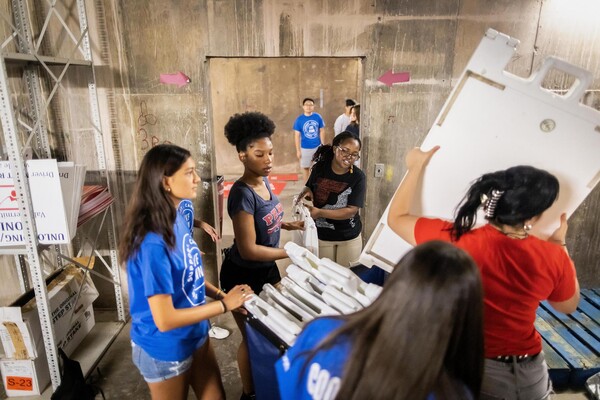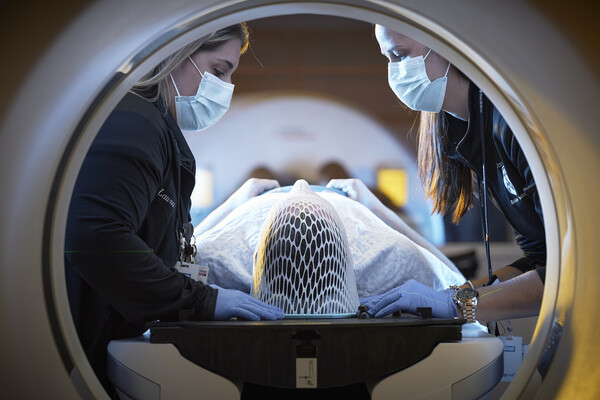On a sacred quest
Following the success of “Historic Houses of Philadelphia” (Penn Press, 1998), Roger Moss has spent the last three years working on a second volume, “Historic Sacred Places of Philadelphia” (Penn Press, 2004). Teaming up once again with architectural photographer Tom Crane, Moss takes readers of the newly published book on a history-rich visual tour of some of the city’s finest places of worship. Though packed with scholarly insight and historic research, it’s as much a coffee table book as an academic tome. And that’s just how Moss wants it.
“I’ve been an academic all my life,“ says the architectural historian, who has been an adjunct professor of architecture in Penn’s School of Design since 1981, teaching courses on historic site management and other topics. “I swore that I wouldn’t write for 200 of my colleagues, and most of my books have in fact been targeted at a popular audience.”
For this book, Moss zeroed in on 50 sacred places. Some, like Christ Church and Gloria Dei, are familiar stops on the tourist route. Others, like the tiny Church of Saint James the Less in North Philadelphia, are hidden gems that Moss delights in sharing. “It’s a dream,” he says of that church, which reminds him of the English parish churches he saw as a visiting graduate fellow. “You’re in Kent!”
Q.When you worked on “Historic Houses of Philadelphia” you told me you would often remove furniture that wasn’t of the right period and move things around to get the picture you wanted. What kind of issues did you face photographing in churches?
A. Well, in the churches we didn’t have to work so much with collections. The pews are screwed down, but on a number of occasions we asked the minister or the priest or the rabbi if we could move the chairs around in the chancel, and it’s a very sensitive thing because we were dealing with Roman Catholics, Greek Orthodox, Conservative and Reform Jewish synagogues, low-church and high-church Protestants, so one of the tricky things about it was to not violate any taboo. ... You have to respect the traditions and the niceties of each of these sacred places because they are sacred places. If we ask for the Torah scrolls to be put out it’s not something you do lightly.
Q.Many of these buildings are familiar landmarks in the city, but few of us have seen the interiors, and they’re quite stunning.
A.These are cultural artifacts. They represent in many cases some of our finest architects, people like Lebrun and Frank Furness and John Notman. And then the decoration! If you were building a church or a synagogue you would want to glorify God the best you could, so you go to a church like Saint Stephens [19 S. 10th St.] and the building is designed by William Strickland, one of the great 19th-century architects of America, the man who designed the Second Bank of the United States. And when you walk in it’s filled with ecclesiastical art that’s of museum quality. People walk by it all the time in Center City and never realize that you could go in there at midday and walk around as if you were going to the Art Museum.
Q.You’ve included phone numbers for each church, and I know one of your criteria was that the churches should be accessible.
A.I can remember as a young architectural historian being able to go to almost any sacred place and open the door and walk in. There would be a handful of people meditating or praying. There might be a priest or a minister puttering around. Today because of fears of vandalism and so on you really have to call in advance for many of them. But if you want to see the interior of Furness’s First Unitarian Church for instance, you can get in. A lot of possible candidates were omitted because they were too hard to get into. ... If I couldn’t get in to photograph, with repeated tries, then how is the average person going to get in?
Q.What were some of the other criteria? You say in your book that Philadelphia has 16,000 congregations. That’s a lot of churches.
A.Many of them of course are meeting in storefronts and basements and so forth, but when you think of the number of actual churches and synagogues and meeting houses of all faiths, there are hundreds and hundreds. So I started out by saying, “What do you do with a building like the Church of the Redeemer?”
It’s a fabulous Arts and Crafts church in Bryn Mawr, and I remember my children saying, “Daddy, surely you’re going to include it,” and I said no because I decided we had to limit the book; they had to be in the city of Philadelphia and they had to be 100 years old.
Q.In the introduction you talk about how you fell in love with ecclesiastical architecture on a trip to England. Why did you have to travel 3,000 miles to do that?
A.I was born and raised in the Midwest. Part of my family were Congregationalist, so I knew absolutely plain—meeting-house plain—churches. … so here I go jetting off to look at English country houses and I’m hit over the head by cathedrals and parish churches with 14th-century graveyards.
Q.In your book you feature churches, like Holy Trinity on Rittenhouse Square, that have narrowly escaped the wreckers’ ball and where preservationists seem to have been at odds with the clergy.
A.In that case, [the rector] felt that the responsibilities of the parish would best be served by disposing of the church. I don’t think he set out to be a vandal. I think he set out with a belief system that was deeply ingrained that his responsibility as a churchman was to serve his congregation’s needs and you don’t do that necessarily by putting money into a big old Victorian church. … Now [30 years after the congregation saved the church by voting to preserve it], Holy Trinity is much beloved.
Q.Then there’s the church that was moved rather than demolished…
A.Oh yes, Saint Clements. That’s a glorious story. As a result of the renovations that took place to build the Parkway, they widened the street and they meant to tear the church down. The architect said there’s no need to tear the church down—we’ll just jack it up and move it. There’s a photo in the book of them moving it. It’s just great.
Q.What about adaptive reuse, when a church gets a new lease on life as an office building or a theater? Is that a success or a failure?
A.I think the point the book tries to make is that it’s better to have saved an architecturally important sacred place by allowing it to be used for another purpose.
The fact is we are not going to be able to save every sacred place, so what makes it sacred? That’s the question. Isn’t what makes it sacred the act of worship? So if worship no longer takes place, it becomes simply a building that happens to have ecclesiastical form.
Q.You write about examples of churches selling to other congregations.
A.There are a surprising number of instances where the building is not serving the congregation who built it. One example is St. George’s Cathedral on 8th Street, designed by John Haviland, an English-born architect who came to Philadelphia in the early 19th century. ... He designed that wonderful Greek façade for his Episcopal congregation. He was buried in the vault and the church was eventually sold to a Greek Orthodox congregation. The building is saved, it’s being used and cared for by the congregation. There’s as much praying going on in there as there was when it was built. By the way, they moved Haviland. When they sold the church, they dug him up.








